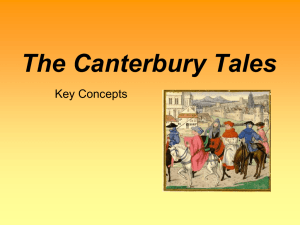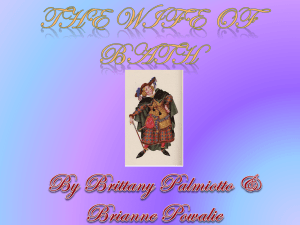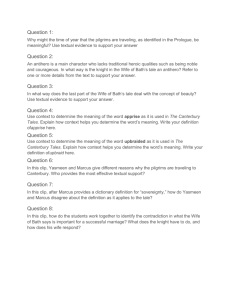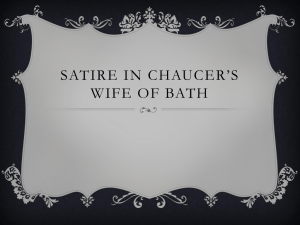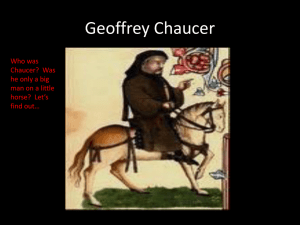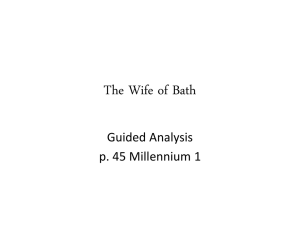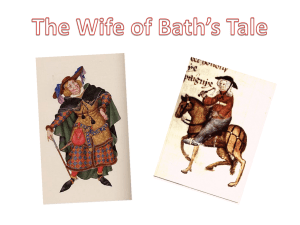B - WordPress.com
advertisement
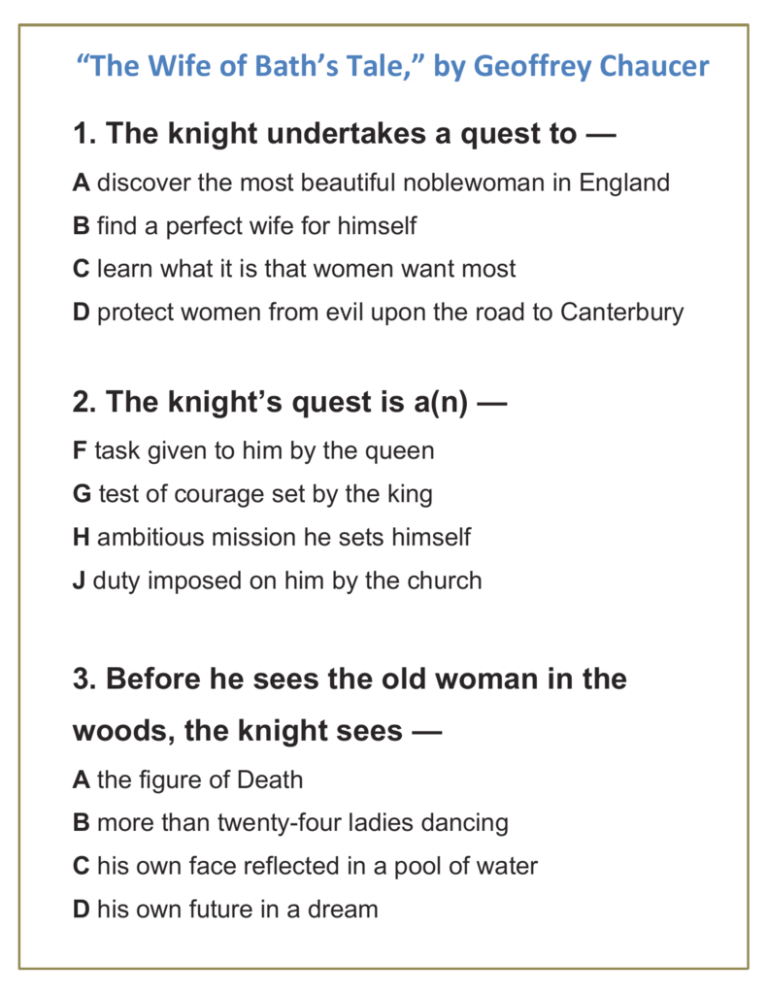
“The Wife of Bath’s Tale,” by Geoffrey Chaucer 1. The knight undertakes a quest to — A discover the most beautiful noblewoman in England B find a perfect wife for himself C learn what it is that women want most D protect women from evil upon the road to Canterbury 2. The knight’s quest is a(n) — F task given to him by the queen G test of courage set by the king H ambitious mission he sets himself J duty imposed on him by the church 3. Before he sees the old woman in the woods, the knight sees — A the figure of Death B more than twenty-four ladies dancing C his own face reflected in a pool of water D his own future in a dream “The Wife of Bath’s Tale,” by Geoffrey Chaucer 4. According to the old woman, what women really want is — F money, jewels, and treasure G to be flattered and attended to H freedom and entertainment J mastery over their husbands 5. As a reward for giving him the answer that will save his life, the old woman demands — A a large sum of money B to learn the secret of youth C to marry the knight D to be pardoned by the queen “The Wife of Bath’s Tale,” by Geoffrey Chaucer 6. The knight shows that he has learned what women want most when he — F keeps his promise to return after a year and a day G agrees to marry the old woman H pays the old woman as much as she asks J asks his wife to decide which form she will take 7. The old woman makes an eloquent philosophical argument about — A the harmfulness of greed B true and false gentility and virtue C the differences between men and women D the magical beauty of nature “The Wife of Bath’s Tale,” by Geoffrey Chaucer 8. The Wife of Bath’s philosophy of marriage shows that she — F is a strong person with a keen sense of her own rights G tends to say one thing and do the opposite H cares only for pleasure, not for right and wrong J trusts too much to thought instead of feeling 9. Chaucer’s characterizations of the Prioress, the Monk, and others connected with the church are mainly— A idealized B realistic C flattering D satirical “The Wife of Bath’s Tale,” by Geoffrey Chaucer 10. Who narrates the tale about the knight and the old woman? F The knight G The old woman H The Wife of Bath J Chaucer 11. The narrator of a story should not be confused with — A the author B the main character C one of the minor characters D the storytelling voice “The Wife of Bath’s Tale,” by Geoffrey Chaucer 12. Which adjective does not describe the Wife of Bath’s narrative voice? F mournful G witty H lively J earthy 13. Which of the following quotations from “The Wife of Bath’s Tale” is a couplet? A “In honor to us both, I don’t care which; / Whatever pleases you suffices me.” B “The knight thought long, and with a piteous groan / At last he said, with all the care in life . . .” C “His heart went bathing in a bath of blisses / And melted in a hundred thousand kisses . . .” D “May I go howling mad and take my life / Unless I prove to be as good and true . . .” “The Wife of Bath’s Tale,” by Geoffrey Chaucer 14. The Wife of Bath’s opinions suggest that she may be described by all the following words except— F well-read G humorous H modest J bossy Written Response: Chaucer used lots of couplets, many of which are lost in translation. Identify at least two places where the translator used half or slant rhyme. Find at least two other places where sound devices are used. What commentary does “Wife of Bath’s Tale” make on honor, knights, and heroes? “The Wife of Bath’s Tale,” by Geoffrey Chaucer “The Wife of Bath’s Tale,” by Geoffrey Chaucer Using specific details from the text as support, what is the Wife of Bath’s view of life? What evidence is there that this may be different from Chaucer’s view of life? Why is this Medieval tale such an interesting candidate for Postmodern revival?
